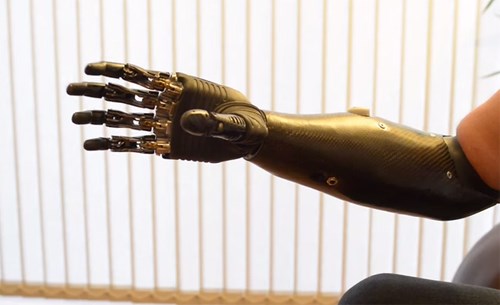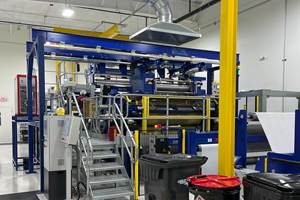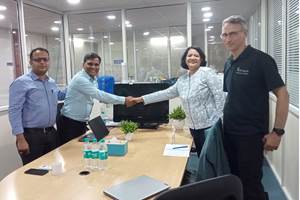2014 SBIR funding solicitations are short on composites
However, the industry should note trends revealed in the areas DoD prioritizes for technology research and transfer.

Prosthetic limbs fabricated from composites are among the SBIR-funded projects
that are garnering more attention.
Out of the 21 topics released online in the U.S. Department of Defense (DoD) fiscal year (FY) 2014.3 Small Business Innovation Research (SBIR) funding solicitation, only one directly lists composites. The description for “Replacement Nose Fairing Material” is listed below. Instead, most of the research topics deal with sensors, microelectronics or modeling and computing, though the Navy’s subgroup includes “Optimization of Advanced Wireless Textiles” and “Advanced Textile Manufacturing Using 3D Printing”.
For the composites industry, the take-home is to note the push to integrate sensors into everything, from cargo containers to clothing to the next generation of night vision goggles. In the case of containers — the Defense Threat Reduction Agency’s (DTRA) topic “Smart Materials to Indicate Personnel Presence in Proximity to Container” — the DoD would like to replace cameras, infrared sensors and visual inspection by guard forces with a means to maintain security that does not require staffing and is not easily disabled. The research description suggests that integrated/embedded sensors will need to detect multiple signatures, for example motion, body heat and molecular compounds emitted during breathing.
Another interesting topic is the Defense Advanced Research Projects Agency’s (DARPA) “Energy Harvesting for Next Generation Neurotechnology”. Basically the DoD wants to advance Neuroprosthetics — which already can actuate prostheses based on closed-loop sensing and computation — by replacing batteries with biomedical energy harvesting technologies. This also reflects a larger trend outside the military. Bionics are here. They are still expensive and in development, but they are no longer science fiction. Both of the devices in the videos below from Ekso Bionics and BeBionic use carbon fiber composite laminates.
Prosthetics has always been a market for composites, but with advances in electronics and injured troops returning from Iraq and Afghanistan, the push to improve this technology into self-powered neuroprosthetics that are actually affordable has ramped significantly.
Finally, there is another round of funding available for awards in 2014, this one known as the DoD FY 2014.B Small Business Technology Transfer (STTR) Solicitation. Of the 13 topics included here, only DARPA’s “Revolutionary Airlift Innovation” implies composites, seeking unmanned gliders to perform cargo lift operations from ship to unsecured shore areas. The Missile Defense Agency (MDA) topic "Failure Avoidance in Microelectronics Due to Coefficient of Thermal Expansion (CTE) Mismatch of Substrates and Adhesives” reflects a large trend in the printed circuit board (PCB) industry — reportedly the largest consumer of glass fiber — to develop higher laminate performance and thermal capacity as electronics get smaller and more sophisticated. Watch for our full-length feature on that in the October issue of Composites Technology magazine.
NAVY N143-130 Replacement Nose Fairing Material
DESCRIPTION: The Nose Fairing provides hydrodynamic and aerodynamic stability during launch and flight. The Nose Fairing provides a direct interface during onload and offload of the missile while supporting the entire weight of the missile. Navy Strategic Systems Programs (SSP) desires to develop a replacement material with the following parameters:
Service Life Goal - 50 years
Nominal Thickness - 0.5 inch
Tensile Strength – Longitudinal > 8.0 ksi Property quantified to B-Basis**
Tensile Strength – Hoop > 2.5 ksi Property quantified to B-Basis**
Bending Strength – Longitudinal > 5.0 ksi
Shear Strength > 1.6 ksi Property quantified to B-Basis**
Internal material damping - Loss Factor = 0.01 or higher
Radio Frequency Transparent in the GigaHertz region of the electromagnetic spectrum (EM) spectrum
Density - 0.58 gm/cc.
Manufacturability – Must be able to form into a complex curvature (doubly curved shell of revolution)
**At least 90 percent of the population of values is expected to equal or exceed the B-basis mechanical property allowable, with a confidence of 95 percent.
REFERENCES:
1) Payload Fairing. http://en.wikipedia.org/wiki/Payload_fairing
2) Nose Fairings on Rockets and Ballistic Missiles. http://www.gpo.gov/fdsys/pkg/GPO-CRPT-105hrpt851/pdf/GPO-CRPT-105hrpt851-2-6.pdf
KEYWORDS: Strategic Missiles; Composite Materials; Materials Development; RF transparent structural materials; Ultrastrong materials; Nanocomposites
TPOC: Roderick Santander
Phone: (202)433-5839
Email: roderick.santander@ssp.navy.mil
2nd TPOC: David Olson
Phone: (202)433-5807
Email: David.Olson@ssp.navy.mil
Related Content
Materials & Processes: Resin matrices for composites
The matrix binds the fiber reinforcement, gives the composite component its shape and determines its surface quality. A composite matrix may be a polymer, ceramic, metal or carbon. Here’s a guide to selection.
Read MoreEpoxy-based structural film adhesive intended for aerospace, MRO
CAMX 2023: Park Aerospace is presenting its new aerospace-grade film adhesive material Aeroadhere FAE-350-1, in addition to other product offerings intended for aerospace, defense and spacecraft.
Read MoreScott Bader partners with Elixir for Crestabond distribution in India
Crestabond MMA structural adhesives range will continue to drive advanced composites growth in India, in addition to Scott Bader’s global expertise and local technical support.
Read MoreHenkel receives Airbus qualification for European aerospace manufacturing facility
The adhesive company’s Montornès, Spain, plant has been approved as a standard and raw materials supplier for various Airbus platforms, adding to its work in lightweighting, fuel efficiency and automation.
Read MoreRead Next
From the CW Archives: The tale of the thermoplastic cryotank
In 2006, guest columnist Bob Hartunian related the story of his efforts two decades prior, while at McDonnell Douglas, to develop a thermoplastic composite crytank for hydrogen storage. He learned a lot of lessons.
Read MoreComposites end markets: Energy (2024)
Composites are used widely in oil/gas, wind and other renewable energy applications. Despite market challenges, growth potential and innovation for composites continue.
Read MoreCW’s 2024 Top Shops survey offers new approach to benchmarking
Respondents that complete the survey by April 30, 2024, have the chance to be recognized as an honoree.
Read More










.jpg;maxWidth=300;quality=90)











